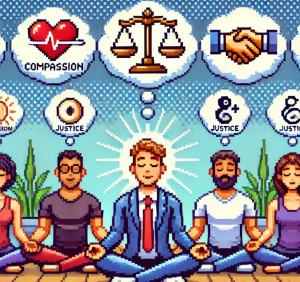
Looting Isn’t the Norm
When disasters strike, the stories that often flood our newsfeeds are those filled with chaos and crime—looting, panic, and antisocial behavior. It paints a picture of humans at their worst, driven to desperate measures by catastrophe. But is this really what happens during disasters? Or are we simply drawn to these dramatic depictions because they make for sensational headlines? This blog dives into research examining common misconceptions about human behavior during disasters and sheds light on what actually happens when communities face the unimaginable.
Debunking the Disaster Myths
In the world of disaster response, there is a persistent belief that human behavior unravels in the face of calamity. From Hurricane Katrina to the Haiti earthquake, media reports often focus on looting, crime, and widespread panic. However, research tells a different story. These behaviors, commonly referred to as maladaptive, are much less prevalent than the media leads us to believe.
Take the work of disaster researchers like Quarantelli, who pointed out decades ago that behaviors such as rioting and looting are not the norm during crises. Instead, they are the exceptions. The real story, hidden behind the attention-grabbing headlines, is that most people respond to disasters with acts of kindness, cooperation, and resilience.
This discrepancy between perception and reality has serious consequences. When we expect maladaptive behaviors, resources—like law enforcement and emergency response—are often misallocated, leaving communities under-supported in areas where they truly need help.
Why the Myths Persist
Why do these myths persist if research consistently debunks them? One major factor is the media’s portrayal of disasters. Sensational stories of looting and lawlessness draw viewers and readers, and in our digital age, these narratives spread even faster on social media. But research shows that these incidents are rare and often exaggerated.
Studies from major disasters like Hurricane Katrina show that while looting occurred, it wasn’t as rampant as depicted. In fact, most of the looting was need-based—people scavenging for food, water, and other essentials in the face of severe shortages. Similarly, after the Haiti earthquake, while some pockets of violence existed, the overwhelming response from the population was one of solidarity and mutual aid.
The focus on negative behaviors overshadows the positive. Communities come together during disasters. People pull each other from rubble, share scarce resources, and organize shelters. This altruism is far more common than looting or rioting, yet it rarely makes the front page.
Case Studies: When Disaster Hits
Let’s take a closer look at three high-profile disasters—Hurricane Hugo, Hurricane Katrina, and the Haiti earthquake—to better understand how maladaptive behaviors are perceived versus the reality on the ground.
Hurricane Hugo and St. Croix
When Hurricane Hugo ravaged the island of St. Croix in 1989, media outlets zeroed in on reports of looting, painting a picture of a community in chaos. However, researchers found that the looting was localized and largely driven by desperation. With 90% of homes destroyed and little government support, residents felt they had no choice but to take what they needed to survive. Class inequality and pre-existing crime rates also played a role, but the vast majority of the population remained focused on survival and rebuilding.
Hurricane Katrina
Hurricane Katrina was a turning point in disaster coverage, as media stories amplified fears of lawlessness in New Orleans. Images of looters dominated the news, leading to widespread panic and a reluctance to evacuate among many residents. But research conducted after the storm shows that these depictions were not entirely accurate. Most looting targeted businesses, not homes, and was often driven by the need for basic supplies. In the weeks following the storm, altruism and camaraderie emerged as dominant behaviors, with neighbors helping each other survive the harsh conditions.
The Haiti Earthquake
The 2010 Haiti earthquake killed hundreds of thousands and displaced millions. Reports of looting and violence quickly surfaced, with news outlets painting a grim picture of the aftermath. But again, these stories were only part of the narrative. While there were instances of unrest, the vast majority of Haitians responded with resilience. People dug through rubble to rescue others, shared food and water, and came together to rebuild their lives. The media’s focus on violence ignored the broader reality of community solidarity.
The Media’s Role in Shaping Perception
The way disasters are reported plays a huge role in shaping public perception of human behavior during crises. Sensational stories sell, and the portrayal of looters and criminals during disasters often reinforces harmful stereotypes about the communities affected. In some cases, these narratives can lead to real-world consequences, such as the over-policing of disaster-stricken areas or the misallocation of emergency resources.
In truth, most people who live through disasters exhibit pro-social behaviors. Studies show that individuals are more likely to help each other than to harm. The media, however, tends to frame disasters as chaotic events where law and order break down. This narrative not only distorts reality but can also discourage people from evacuating their homes due to fears of crime—fears that are often unfounded.
Real Disasters, Real Responses
So, what’s the reality when it comes to human behavior during disasters? More often than not, people rise to the occasion. They help their neighbors, they share resources, and they work together to rebuild. Yes, there are instances of looting or criminal behavior, but these are the exception, not the rule. When we focus too much on these exceptions, we risk missing the larger picture of human resilience and solidarity.
Public health practitioners and emergency responders need to be aware of these misconceptions and plan for the realities of disaster behavior. By focusing on the positive responses that dominate in crises, communities can be better supported in their recovery efforts. Instead of deploying resources to prevent looting, efforts could be better spent on ensuring access to food, water, and medical care—things that can prevent need-based looting in the first place.
Join the Conversation
What are your thoughts on disaster myths and the media’s role in shaping perceptions of human behavior? Have you experienced or witnessed responses to a disaster that contradicted common stereotypes? Share your experiences in the comments or on social media using #DisasterMyths.



